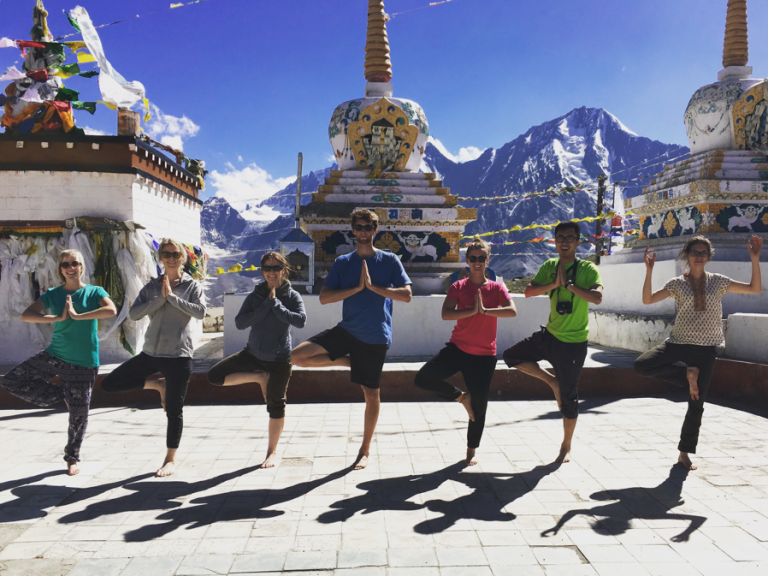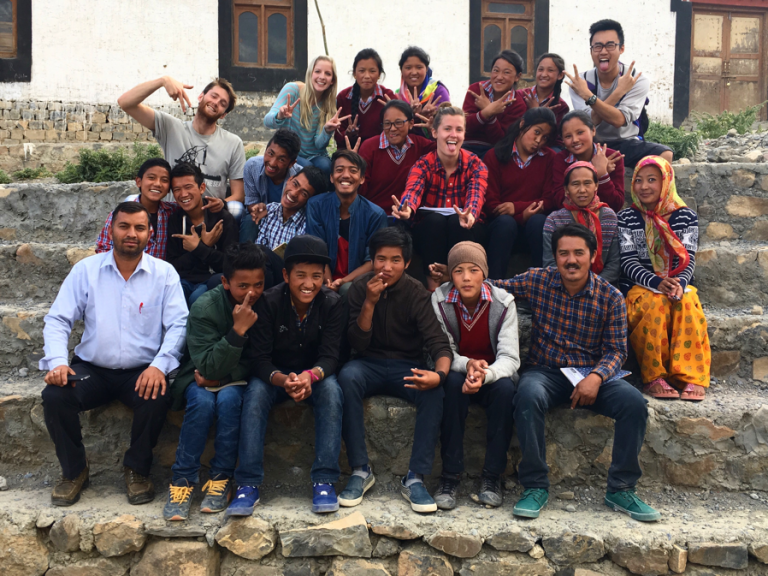Written by Shandel Riedlinger, MD 2019
It was only after a 16-hour drive from Delhi to Manali, and half way through another 12-hour drive from Manali into the Spiti Valley, that I realized I was truly spending the next month in the middle of nowhere. The roads had become worse, turning from rough pavement to gravel and dirt. It made our progress very slow as the drivers navigated around potholes, large rocks and herds of cows and horses.
As I looked out the front window of the Jeep, I saw goats speckling the mountains in the distance and realized it had been hours since we’d seen any sort of building… or people for that matter. Within minutes, however, a temple covered in ceremonial prayer flags came into our view. There was nothing around it for miles and it was located at an elevation of 4,500 metres above sea level. It was absolutely fascinating. The breeze was so strong, all we could hear was the sound of prayer flags flapping in the wind. My fingers and toes tingled from the medication we were taking to prevent altitude sickness. Whatever way you looked, you saw beautiful mountain views.

Members of the 2016 Spiti Team. (L to R) Shandel Riedlinger, Dr. Caroline MacCallum, Rebecca MacLean-Angus, Alex Mezei, Megan Shurey, Colin Tan, and Nicole Bernardi.
After a few hours, we passed through an archway that welcomed us to the Spiti Valley. We had finally entered one of the most remote and unpopulated regions of India.
For the next month, myself and four other UBC medical students worked at the Munsel-ling Boarding School; the heart of a small village nestled within the Himalayan mountains. With the help of a Canadian physician and two local nurses who worked at the school, we performed health screens on over 500 children. We screened for a number of health concerns, including anemia, scabies, worms and lice, as well as for vision, dental, cardiac, respiratory and gastrointestinal problems. What we didn’t expect was the magnitude of the prevalence of these health problems.
Our first day of screening was a sobering experience. Student after student was examined, each with visible nits glued to their hair. More than 90% of the girls at the school had lice. Clearly, the original plan to treat a small number of students would be futile and we needed to treat at the population level. The entire school would require lice shampoo.
Additionally, almost all of the children had cavities, and many had rotting teeth. The cause was multifactorial, including a lack of access to dental care, a diet filled with sugary treats, and a lack of education on tooth brushing. We worked with the nurses to enhance the curriculum on dental hygiene and ensure they were given adequate class time to present this material. After meeting with a healthcare team at a nearby village, we found out that for the first time in years, a dentist was willing to take on the challenge of treating the students.
Through blood testing, we were also able to identify children who were severely anemic. They were prescribed iron supplements provided free of charge from the government and would have follow up visits with one of the doctors on the healthcare team we’d met. To ensure the sustainability of these interventions after we had left, it was important to help the students access local resources.
During our time at Munsel-ling, we worked with students anywhere from 4 to 19 years old, but it was the kindergarten class that was the most challenging and entertaining. Although the older students could speak English and Hindi, the younger ones barely spoke anything but their traditional Spitian language. We relied heavily on the nurses to help us translate. One of my favourite moments was pointing to the vision chart expecting the five-year-old in front of me to not quite understand, until a tiny voice piped up and said “E is for Elephant!”. She managed to make it through the full row of letters perfectly listing off the corresponding animals.
In the evenings, we entered the data we’d collected for the day, ate traditional meals with the teachers, and revelled in the slow pace of the village. On our first few nights the stars would come out, giving us a perfect view of the Milky Way and the time to reflect on the incredible journey we were on. Later in the month, the moon was so bright it perfectly lit our path as we headed to bed after dinner.
In an odd way, the days passed by slowly as the month flew by. It was a month I will never forget. Whether it was the people I travelled with who turned into family, the kind words we received from the teachers and staff, or the absolute trust that filled the students’ eyes, I will always remember how these experiences have shaped me. I grew as a traveller, as a medical student and as a person.
